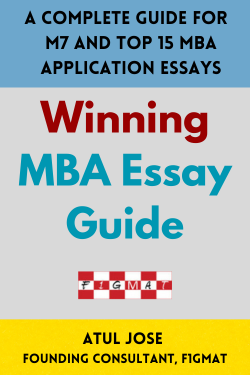I have explained 5 strategies to introduce segues in MBA Essays. Those strategies are shared with the assumption that you understand themes in Segues.
Themes in Segues are the foundation on which professional writers transition from one sentence to another or from one paragraph to another. Otherwise, every sentence will have a transitioning word or a phrase. Every paragraph will be referring to the previous paragraph with a phrase.
We, as humans, have excellent skills in filling gaps in the narratives.
I have noticed 5 segue themes in my Essay Writing and Editing career are:
1) Personality Trait
If an applicant starts a DEI MBA essay with a personality trait, the reviewer will be curious why the essay started with a reflection on their personality.
An excellent essay I read was around introversion – a risky theme while applying to extroversion heavy MBA programs where case study and other group exercises require high level of peer-to-peer engagement.
The personality trait highlighted in the first paragraph was a hook - introversion when the conversations are not from her area of expertise and extroversion on topic when the topic was her favorite cause. It was the applicant’s strategy to demonstrate ambiversion – a mix of introversion and extroversion. But starting with introversion hooked the reader.
By sharing a personality trait, the applicant was introducing her listening skills. Then, when the second paragraph started with a consulting engagement for a non-profit, she shared an interview with a beneficiary that revealed an interesting gap in implementing a policy. That gap was found because she listened and didn’t interject when the topic switched to water utilization in the community.
It is not always self-reflective.
Some narratives have examples of analyzing the personality traits of a mentor, caregiver, beneficiary or even an antagonist.
Negatively analyzing a personality trait needs absolute care. It will sound silly if you evaluate a person’s one-time transgression or behavior under duress as a generalization of the person’s traits.
Always seek second opinion when you are criticizing a person in an essay. My editing involves polishing the criticism in such a way that the larger problem of society is highlighted instead of the personality. That approach always shows maturity.
Schools need candidates who are mature and engage in conversations – even controversial topics without letting their emotions cloud their judgments.
2) Identity – The Most Prominent Identity, Two if the second identity is Relevant
The strong and high-charged conversations in X or any social media or forum threads are from one underlying behavioral flaw.
In social media, one’s primary identity under which a topic is discussed gets accentuated. The assumption about the person’s worldview is immediately reached based on the side the person takes on the topic.
There is no room for nuance or backstory or a history of participation in multiple causes or association with multiple identities that is revealed when a person engages in a debate or a conversation with another person.
In MBA Essays, such extension of identity-focused narrative has a remarkable success rate.
If you are from an LGBTQ+ profile, it would be a missed opportunity not to create at least one narrative around your identity.
Several applicants bring the same identity as the pillar on which perspectives are offered on multiple work, professional, or extra-curricular initiatives.
Such segues on identity have a high success rate.
An applicant shared the fear of offering a consulting engagement in a country known for punishing non-traditional sexual orientations. That was the thread that segued to understanding the large beneficiaries who will be disrupted by disinvestment from Oil and Gas revenues. The applicant’s consulting team had to build a rehabilitation and re-training program. The success of his engagement was primarily driven by his laser-focused awareness of the marginalized in society like himself.
So by connecting his identity as a gay person with the marginalized who didn’t have the foundational education to re-train, he suggested a policy intervention that would offer the next to kin of the under-educated with additional incentives to support the aging and in many cases, unemployable parents.
Can you expand to two identities?
With open-ended essays that have 2-page or 750-word limits, you can explore two identities. But for, let us say, an LGBTQ+ applicant, identities outside professional identity are a tricky pursuit. Avoid mentioning it if you have other interests outside your profession.
If a school already has successfully increased the intake of one demographic, keeping the identity as the core of the narrative will be counterproductive.
Here, strategy outshines narratives.
3) Life Experiences – Childhood, Trauma, or Inspiring (meaning)
Negative Event -> Cause
Trauma -> Cause
Inspiring -> Cause
I want to start with the bad news about the human psyche. Our tendency is to pay attention to the negative narratives.
We are never inspired to take on a new initiative without some setback.
There is a whole new generation of morning walkers who started walking consistently after a stroke.
A whole new generation of gym attendees after gaining over 10 pounds.
Our behaviors and perspectives change after a negative outcome.
So, writing a positive-themed narrative before segueing to a cause has the least impact unless the inspiring person or event is globally renowned or the focus of the narrative is the beneficiary.
A chance to participate in a Special Olympics as a volunteer after a friend asked for a favor to fill in for her became a motivation for an applicant to offer consulting services for an architecture design company. The company was integrating wheel-chair access to 100-150 year old government buildings. The gap from volunteering to now offering consulting service for design is 10 years. The involvement were continuous – at least once a year.
Such segue works when the narrative focuses on the beneficiary instead of applicants themselves and there is a long association of helping the beneficiary.
We can’t change human thinking that has kept us on a path of survival for millions of years.
Prioritize negative events.
One client shared the toxic work culture in a startup that triggered her exit. On joining another venture, she ensured that the seeds of the previous work culture never took root. By engaging with the talent team and starting a social engagement event on building awareness of belonging and equity, she started a training program for newly recruited candidates that continue to offer critical orientation on working in a diverse team.
Editor’s Note: Trauma as a Segue is extremely tricky
I had to discourage applicants from revealing sexual assault in MBA essays, not because those experiences were not valid or relevant but because the applicant didn’t pursue causes that build awareness of such practices in an intense way. Here louder the awareness is built, the more likely the admissions team will connect with the trauma.
Also, don’t segue from such examples if the non-profit’s primary beneficiaries are not aligned with the trauma.
4) Origin – Value, Hobby or Interest
For multi-career applicants, hobbies and interests are essential to offer context on the multiple career transitions.
The origin story is the best way to manage the seed of the interest.
Some of the most interesting narratives are from multi-career applicants.
The risks applicants took while making the career transitions and honesty to accept failure were two themes in the MBA Essay that always got my attention.
Such vulnerability is rare in MBA Essays.
While applying to Stanford, Wharton or Booth, demonstrating vulnerability goes a long way in connecting with the admissions team. But there are disingenuous vulnerabilities that feel manufactured.
Segueing from a paragraph that shows the origin of values to an example of applying the value is the most overused pattern in MBA Essays. Avoid it. There are better ways to connect values without such clear demarcation.
5) Person – Mentor, Caregiver, Parent, Beneficiary or Antagonist
Highlighting mentors, parents, grandparents, or a beneficiary in such a way that the focus of the essay shifts from the applicant is an extremely common problem while editing essays.
Some applicants use it strategically to highlight the early orientation the person received, while many don’t edit the essays to offer a balanced narrative.
The narrative on grandparents is the trickiest because for many in the minority communities, they did have a huge influence on career and life outcome of the applicants. But the essays are always about you. Shortlisting the most relevant examples to highlight their contributions is one way to strengthen your candidacy.
In a 300-word essay, a 50-word to the ‘Person’ who changed your life to a segue into your career or life or volunteering choices is sufficient to create an impactful narrative.
 I will teach you how to bring your life stories to essays faster with F1GMAT's essay guides. Download below or subscribe to F1GMAT's Service and work with me - Atul Jose, Author/Editor/Founding Consultant, F1GMAT(16 Years of helping applicants gain admissions to M7 and Top 30 schools)
I will teach you how to bring your life stories to essays faster with F1GMAT's essay guides. Download below or subscribe to F1GMAT's Service and work with me - Atul Jose, Author/Editor/Founding Consultant, F1GMAT(16 Years of helping applicants gain admissions to M7 and Top 30 schools) 